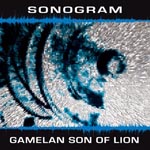|
|
 |
Dusted Reviews
Artist: Gamelan Son of Lion Album: Sonogram Label: Innova Review date: Mar. 13, 2009 |

|
|
|
 |
Equal parts composers collective, new music ensemble, and gamelan troupe, Gamelan Son of Lion performs and records music by American and Indonesian composers. Among the 100 or so gamelan ensembles in the U.S., Gamelan Son of Lion and only a very small handful of others focus foremost on new music for gamelan. Founded in 1976 by a group of composers – Barbara Benary, Daniel Goode and Philip Corner – this greater New York area-based gamelan also happens to be one of the oldest active gamelan ensembles. Even though the highly non-traditional sounds of Sonogram are startling at first, in some sense they’re more in keeping with practices in Southeast Asia where the gamelan originated several hundreds of years ago. Unlike the symphonic orchestras of the Western European tradition (which too often serve as institutional preservation apparatuses for canonic repertoire), gamelan ensembles in Southeast Asia seem to be much more active about continuously commissioning and performing new works. Gamelan Son of Lion doesn’t think about tradition and authenticity as unchanging standards. Instead, composers of the collective make things that are meaningful for their own time and place. They take pride in things like their instruments “built in Indonesian village style,” which means using local NYC raw material like cans, hubcaps and PVC pipes in combination with gongs and drums built in Indonesia. But most of all, the main concern seems to be about getting that new music out there.
Sonogram is a two-disc collection of pieces by the ensemble’s performer/composers David Simons, John Morton, Barbara Benary, Jody Krustal, Laura Liben, Lisa Karrer, Miguel Frasconi, Daniel Goode, David Demnitz, and Denman Maroney. Guest performers on the recording include vocalist Anna Dembska, pianists Marija Ilic and Joseph Kubera, and drummer Bill Ruyle. The compositions on Songram reference a variety of styles from different historical eras and geographical areas, and they show no fear of experimentation. On the first disc, in “She (really) Had to Go,” John Morton treats gamelan sounds with Max/MSP, an interactive electronic music environment. He creates incredible countermelodies and elaborations with gamelan instruments based around the familiar Beatles’ tune “Yesterday” as a main melody –– played on a music box. Benary’s “Jigalullaby” begins with traditional Scottish lullabies from Nova Scotia and elaborates on the melody with the gamelan. My favorite piece on the album is “Telling Time” for gamelan and glass by Miguel Frasconi. It presents a beautiful and dreamy rumination on multiple temporalities. Concepts aside though, I just found the phasing textures of glass instruments and soft metallophones to be quite ethereal.
The second disc begins with a multi-composer collaboration with 9-11: A Memorial Suite. Despite the sense of deep personal and collective mourning, it also offers a prayer-like hope and healing by revisiting the memories, which, I think the formal choice of theme and variation represents. Following the suite, “Kacapi” by Lisa Karrer takes a sad Sundanese love song by the 20th-century Indonesian poet Sitor Situmorang, and accompanies it with an ensemble of the soft instruments of the gamelan, clarinet, bass recorder, and the Chinese zheng and erhu. The instrumentation might seem eclectic, but the piece sounds smooth and gorgeously cohesive.
By Miki Kaneda
|







